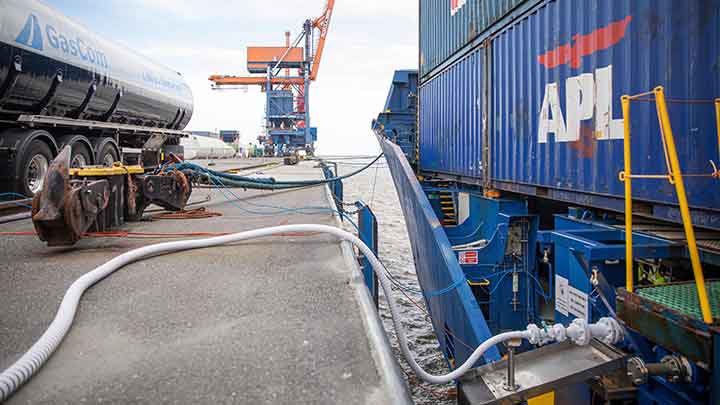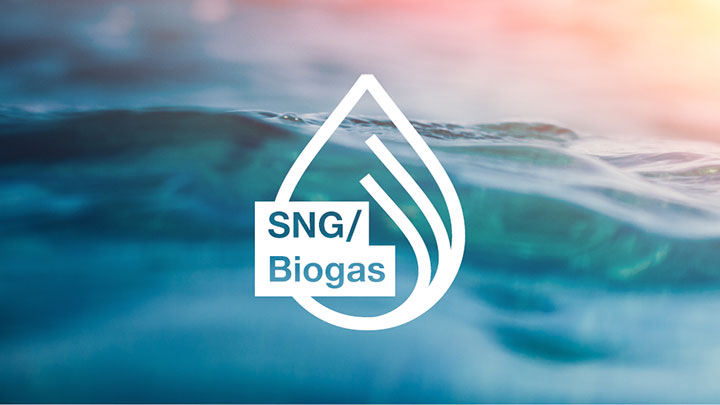SNG: Synthetic gas for the maritime transition

A viable path to decarbonization
MAN Energy Solutions is driving the maritime energy transition with technologies for low-carbon fuels, including green engines and retrofits. Our synthetic natural gas (SNG) solutions offer you a clear path to low-carbon shipping.

From HFO to LNG to SNG
Most of the world's ships run on heavy fuel oil (HFO). The climate crisis has made it essential to find low-carbon alternatives. In recent years, liquefied natural gas (LNG) has become the alternative of choice, but it still a fossil fuel that produces greenhouse gases (GHG). SNG is a new low-carbon alternative. SNG is chemically the same as the main combustible constituent of LNG, so it can used as a direct replacement or blended with LNG, depending on the supply.
SNG as maritime fuel
SNG is optimally suited for the two- and four-stroke dual-fuel engines in MAN’s range and ideal for ships that already run on LNG and aim to save additional emissions. Achieving fuel supply aboard ship is straightforward enough with the right equipment – as with LNG. The new gaseous fuel has to be held at cryogenic temperatures prior to bunkering (-162°C). However, an already established LNG infrastructure can also be used for fueling with SNG.
Reference case: ElbBLUE
World’s first use of SNG in commercial shipping
In September 2021, the 1,036-TEU vessel ElbBLUE, which had been retrofitted with a four-stroke MAN 51/60 dual-fuel engine in 2017, also became the first container ship worldwide to use climate-neutral SNG on a commercial trip. The ship replaced approximately 50% of its bunkered gas fuel with SNG from the Kiwi AG plant in Wertle, Germany. The test proved that any LNG-retrofitted ship can run on carbon-neutral fuels generated by Power-to-X technology.
Read moreManaging Methane Slip
Does the issue of methane slip affect the climate benefits of LNG as an engine fuel for marine applications? Download this paper and find out more about the various countermeasures the company has taken for this purpose.
Synthetic natural gas (SNG) can be derived from fossil fuels and biomass via gasification and methanation processes. SNG can also be produced by, for example, renewable or surplus energy in power-to-gas systems. Biogases are produced from biomass and waste products – and the resulting liquefied fuels can be referred to as BioLNG or LBG (liquefied biogas) and sometimes LBM (liquefied biomethane).
Main advantages:
- SNG and Biogas have the same low NOx, SOx and particulate matter emissions as LNG, but they can be CO2 neutral depending on the feedstock and conversion energy source
- Depending on the source fuel, SNG and Biogas can be a carbon-neutral substitute for fossil fuels
- SNG and Biogas can be blended with LNG to gradually reduce the CO2 footprint
- Considered to be excellent bridging fuels during the ongoing energy transition
Focus areas:
- The availability of SNG and Biogas as bunker fuel
- Increase of production capacities Read more

Solutions / technologies by MAN Energy Solutions:
Two-stroke:
|
|
| Four-stroke: |
|
| Cryogenic equipment |
|
Other future fuels
Related news
MAN 175D Biofuel-Ready
MAN Energy Solutions has announced that its MAN 175D engine is formally approved for operation on biofuels, effective immediately. This applies to all standard biofuels such as HVO (Hydrotreated Vegetable Oil) and FAME (Fatty Acid Methyl Ester) fuels up to a content of 100%. Crucially, the engine itself does not require any technical adjustments, following the announcement.
Florian Keiler, Head of High-Speed Sales, MAN Energy Solutions, said: “MAN Energy Solutions prepares its engines for operation on future and sustainable fuels and the MAN 175D is no exception. Several such units have been running on up to B30 biofuel in commercial, as well as governmental, applications for several years already where our experience has been very good and shown that the 175D does not suffer any loss in performance even when using these fuels. Due to its state-of-the-art design, just a few engine components are subject to slightly higher wear, depending on the amount of biofuel and the duration of operation. For uninterrupted engine operation, only minor adaptations of the fuel-treatment system are necessary.”
Due to the lower energy content of FAME fuels, the engine’s Maximum Continuous Rating would drop if no correction measures were applied. Therefore, MAN Energy Solutions has developed a solution that allows the correction of the load by means of a Fuel Adaption Control ensuring full MCR power, also when operating with 100% FAME fuels.
About the MAN 175D engine
MAN Energy Solutions developed the MAN 175D engine range to supplement and complete its product portfolio in the maritime sector. In three variants of 12, 16 and 20 cylinders, the engine is available with an output ranging from 1,500 to 4,400 Kilowatts and is optimised for propelling ferries, offshore supply vessels, tug boats and other working vessels. Other market areas, such as super-yachts and naval marine applications, are also served by additional, specialist model versions.
It is also an extremely eco-friendly engine, being designed from the outset with compliance to the latest, as well as future, exhaust-gas-emission requirements and utilises a very compact and flexible SCR system, which enables vessel designers to optimise space aboard to the maximum.
Documents
-
PR MAN 175D Biofuels_EN
Contact
Nils Søholt
Trade Press Marine
Group Communications & MarktingEverllenceTeglholmsgade 412450 Copenhagen SVDenmark
nils.soeholt@everllence.com t +45 33 85 26 69Available languages
- DE ·
- EN
Get notified about press releases
Methane-fuelled MAN B&W ME-GI two-stroke engine
The MAN B&W ME-GI has been in service for more than a decade already, and with a continuous focus on optimizing the engine design, it remains a preferred choice across vessel segments and sizes.
Watch the recording of our two-stroke MAN ExpertTalk where we take a closer look at the new 10.7 engine platform, the improved gas return system, and general engine availability.
MAN Energy Solutions is now Everllence.
We have adopted a new brand name and moved to a new domain: www.everllence.com. This page will also be relocated there shortly. We are working on shifting all pages to www.everllence.com.
